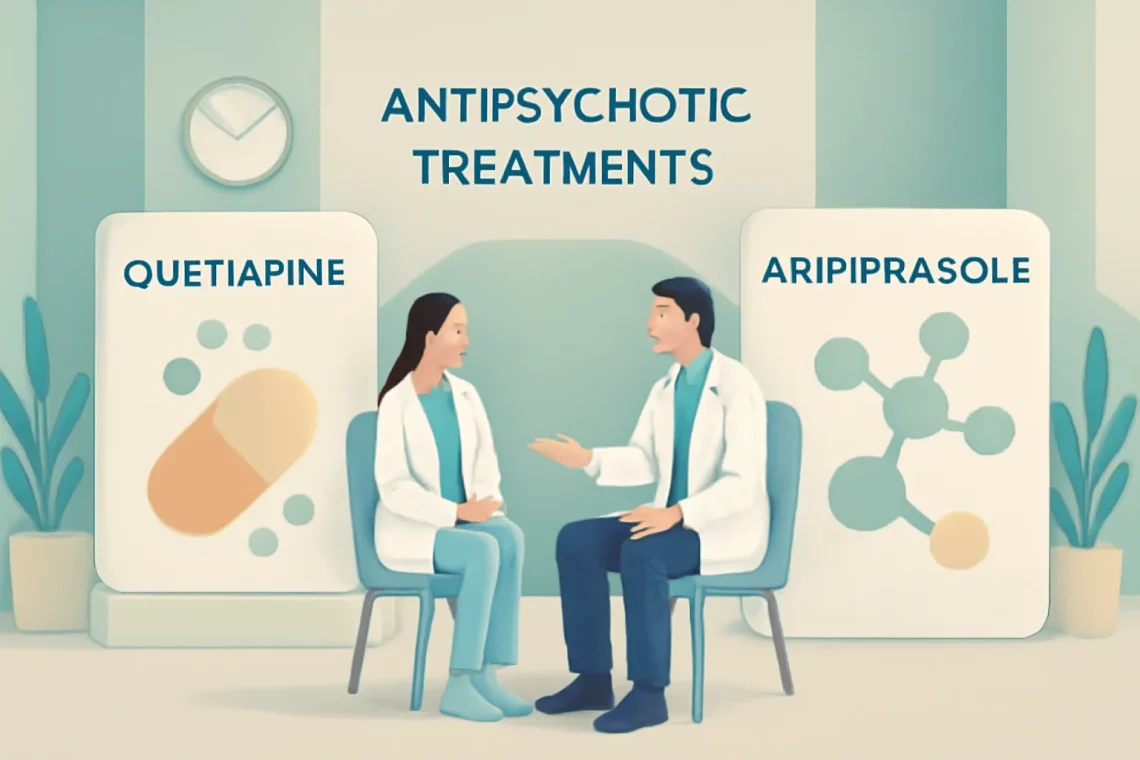-
Risperidone vs Olanzapine: A Comprehensive Comparison for Patients
Risperidone and olanzapine are two commonly prescribed atypical antipsychotic medications used primarily to treat various mental health disorders, including schizophrenia and bipolar disorder. Both of these drugs have garnered attention for their effectiveness, but they also come with a range of potential side effects and considerations that patients and healthcare providers must weigh. The increasing prevalence of mental health issues globally has led to a growing interest in understanding these medications’ benefits and drawbacks. The nuanced mechanisms by which risperidone and olanzapine operate within the brain highlight the complexity of psychiatric treatment. Patients often find themselves at a crossroads when deciding which medication may be more appropriate for their condition.…
-
Risperidone vs Olanzapine: Choosing the Right Antipsychotic Treatment
Risperidone and olanzapine are two commonly prescribed antipsychotic medications that play a crucial role in the management of various mental health disorders. Both belong to a class of drugs known as atypical antipsychotics, which are often favored for their efficacy in treating symptoms of schizophrenia, bipolar disorder, and other psychiatric conditions. As mental health awareness continues to grow, these medications have gained significant attention, leading to numerous discussions about their respective benefits and potential drawbacks. The choice between risperidone and olanzapine can be complex, as it often depends on the individual needs of the patient, the specific symptoms being treated, and the side effect profiles of each medication. While both…
-
Vraylar vs Risperdal: Understanding the Differences and Uses
Vraylar and Risperdal are two medications commonly used in the treatment of mental health disorders. They belong to a class of drugs known as atypical antipsychotics, which are designed to manage symptoms of conditions such as schizophrenia and bipolar disorder. Both medications have unique properties, efficacy profiles, and side effects, making them suitable for different patient needs. Understanding the intricacies of each medication is essential for patients, caregivers, and healthcare professionals. Vraylar, also known by its generic name cariprazine, has gained attention for its unique mechanism of action that targets specific dopamine receptors in the brain. On the other hand, Risperdal, or risperidone, has been a long-standing treatment option with…
-
Cymbalta vs Elavil: A Comprehensive Comparison of Two Antidepressants
Cymbalta and Elavil are two medications frequently prescribed for various mental health conditions, particularly depression and anxiety disorders. As the understanding of mental health evolves, so too do the treatment options available to patients. Cymbalta, generically known as duloxetine, is a serotonin-norepinephrine reuptake inhibitor (SNRI) that has gained popularity for its dual-action mechanism of targeting both serotonin and norepinephrine, neurotransmitters that play significant roles in mood regulation. On the other hand, Elavil, or amitriptyline, belongs to a class of medications known as tricyclic antidepressants (TCAs), which have been used for decades to treat depression, anxiety, and even chronic pain. Both medications have their unique profiles, side effects, and potential interactions,…
-
Xanax vs Alprazolam Understanding the Differences and Similarities
Xanax and alprazolam are terms that are often used interchangeably, leading to confusion among patients and healthcare professionals alike. While Xanax is the brand name, alprazolam is the generic name of the same medication. Both are commonly prescribed for anxiety and panic disorders, but understanding their differences, uses, and potential impacts on health is crucial for anyone considering their use. As the prevalence of anxiety-related conditions continues to rise, discussions surrounding these medications become increasingly relevant. It is essential for individuals to educate themselves about the options available to them, the mechanisms of these drugs, and the implications of their use in daily life. This article aims to clarify these…
-
Quetiapine vs Aripiprazole: Which Antipsychotic Is Right for You?
Quetiapine and aripiprazole are two widely used medications in the field of psychiatry, known for their roles in treating various mental health disorders. As mental health awareness continues to grow, understanding the distinctions and similarities between these two medications becomes increasingly important for patients and caregivers alike. Both drugs belong to the class of atypical antipsychotics, but they have unique mechanisms of action, side effect profiles, and indications that can influence treatment outcomes. Quetiapine, marketed under the brand name Seroquel, is often prescribed for conditions such as schizophrenia, bipolar disorder, and major depressive disorder, especially in cases where traditional antidepressants may not be effective. On the other hand, aripiprazole, known…
-
Quetiapine vs Aripiprazole: Choosing the Right Antipsychotic Treatment
Quetiapine and aripiprazole are two widely used medications in the treatment of various psychiatric disorders. As mental health awareness continues to grow, understanding the differences, benefits, and potential side effects of these antipsychotic medications has become increasingly important for patients, caregivers, and healthcare providers alike. Both drugs belong to the class of atypical antipsychotics, which are designed to target a variety of symptoms associated with mental illnesses, such as schizophrenia, bipolar disorder, and major depressive disorder. Quetiapine, often marketed under the brand name Seroquel, has gained recognition for its sedative properties. It’s frequently prescribed for patients experiencing severe anxiety or insomnia alongside their primary mental health conditions. On the other…
-
Naltrexone vs Suboxone: Understanding the Key Differences and Benefits
Naltrexone and Suboxone are two medications commonly used in the treatment of substance use disorders, particularly opioid dependence. As the opioid crisis continues to affect countless individuals and communities, understanding the distinctions between these medications becomes increasingly important. Both Naltrexone and Suboxone serve unique roles in the recovery process, yet they operate through different mechanisms and have varying applications. Naltrexone is an opioid antagonist, meaning it blocks the effects of opioids at their receptor sites, thereby reducing cravings and the potential for relapse. In contrast, Suboxone is a combination of buprenorphine, a partial opioid agonist, and naloxone, which helps prevent misuse. This combination not only alleviates withdrawal symptoms but also…
-
Citalopram vs Effexor XR: Choosing the Right Antidepressant for You
Citalopram and Effexor XR are two medications commonly prescribed for the treatment of various mental health disorders, including depression and anxiety. As mental health continues to be a significant concern worldwide, understanding the differences between these two medications can help individuals make informed decisions about their treatment options. Both medications have their unique mechanisms of action, side effects, and benefits, which can significantly influence a patient’s response to treatment. Citalopram, a selective serotonin reuptake inhibitor (SSRI), is primarily used to alleviate symptoms of major depressive disorder. It works by increasing serotonin levels in the brain, which can help improve mood and emotional stability. On the other hand, Effexor XR, or…
-
Clonazepam vs Klonopin: Understanding Their Differences and Uses
Clonazepam and Klonopin are often mentioned interchangeably in discussions related to anxiety and seizure disorders. However, despite their similarities, they possess unique characteristics that can significantly influence their use in medical practice. Clonazepam is the active ingredient in Klonopin, a well-known brand name for this medication. As a benzodiazepine, Clonazepam functions by enhancing the effects of a neurotransmitter in the brain called gamma-aminobutyric acid (GABA). This action leads to its sedative, anxiolytic, and anticonvulsant effects. The complexity of benzodiazepines, including Clonazepam and its branded counterpart, extends beyond their pharmacological profiles. Understanding their uses, potential side effects, and the nuances in their application can empower patients and caregivers to make informed…






































